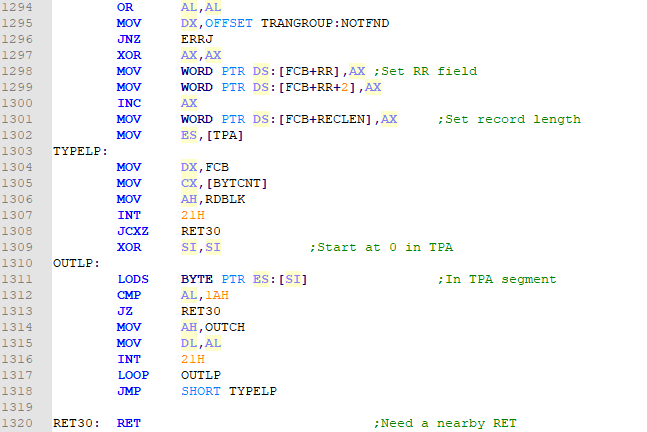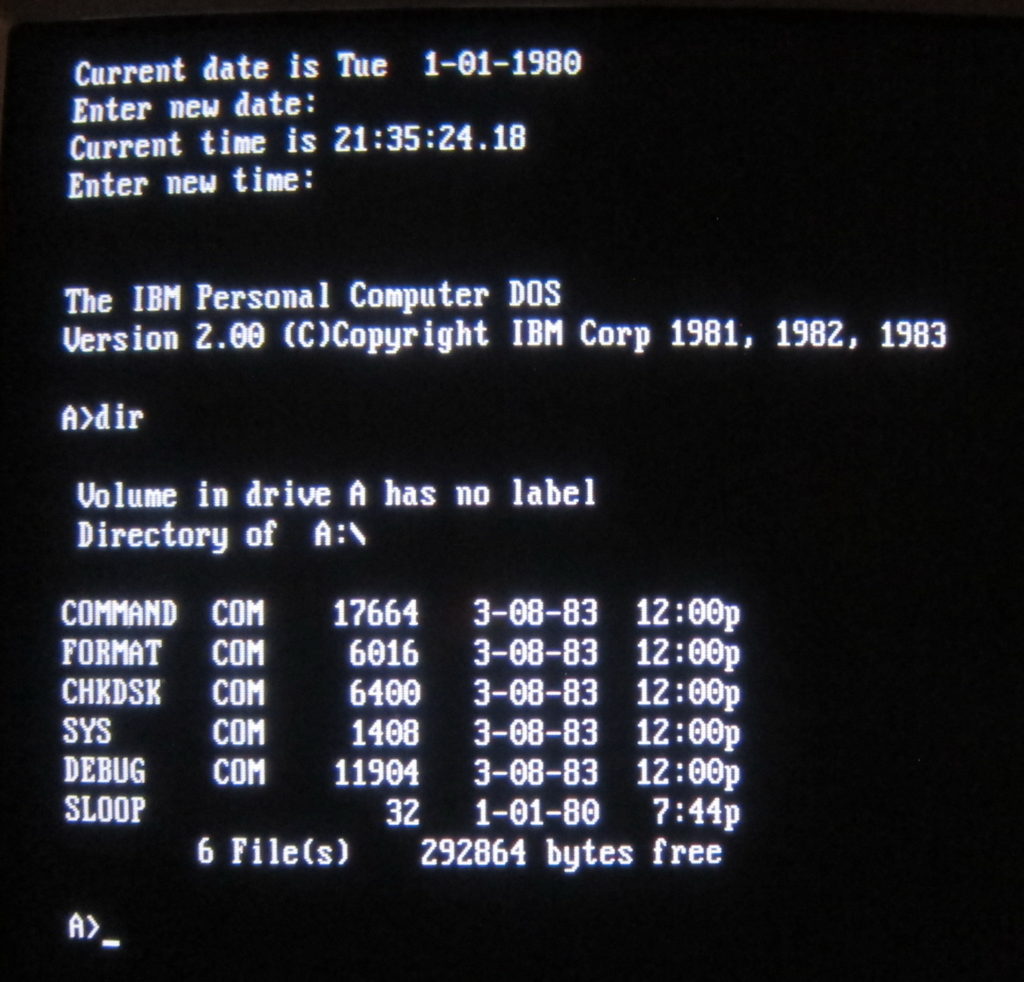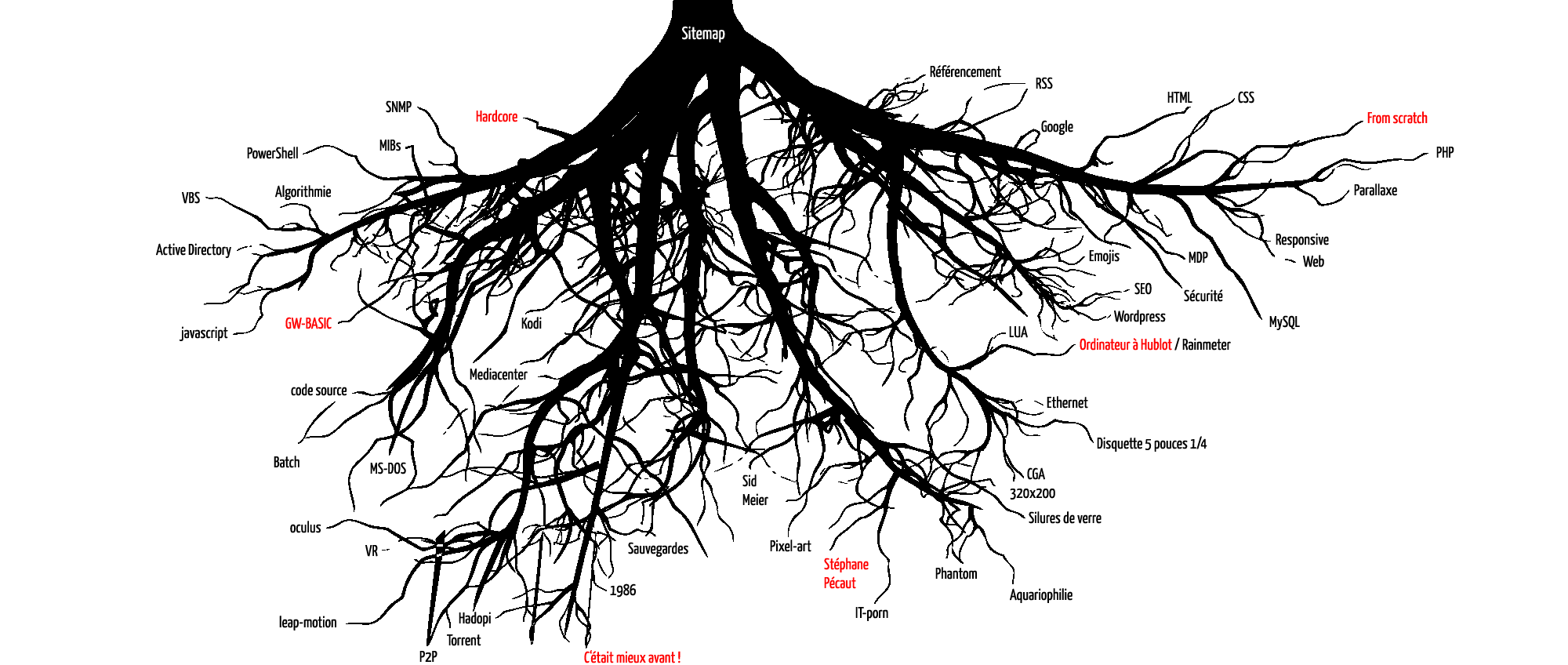Bill Gates et la commande de IBM pour ses PC XT en 1981
Lorsqu’en 1981 IBM commande à Bill Gates un système d’exploitation capable de piloter son IBM-PC XT, Gates rachète QDOS (Quick and Dirty OS), un clone de CP/M écrit par Tim Paterson, et lui demande de l’adapter à l’IBM-PC tout en le renommant MS-DOS (Microsoft Disk Operating System).
MS-DOS restera par la suite le système d’exploitation phare de Microsoft jusqu’en 1995, date d’apparition de Windows 95 à laquelle il devient invisible. De nos jours, l’interpréteur de commandes n’est plus COMMAND.COM mais CMD.EXE
MS-DOS 1.00 sort en juillet 1981 en même temps que le tout premier IBM-PC. Il ne supporte que les disquettes simple face (160 Ko) et 64 fichiers maximum par disquette. Il ne gère pas les répertoires.
MS-DOS 1.25 est la première version vendue par Microsoft.
MS-DOS 2.00 sort en mars 1983 et supporte les disques durs, les répertoires et les disquettes 5 pouces 1/4 double face de 360 Ko.
Microsoft a livré en 2014 le code source de Microsoft MS-DOS 1.1 et 2 (respectivement juillet 1981 et mars 1983) et c’est fun à consulter. Pour l’anecdote aussi, à l’occasion du 1er avril 2015, Microsoft a publié une version de MS-DOS tournant sous Windows Phone.

Le code source de MS-DOS 1.1 & 2 (1981 & 1983)
📃 Parlez-vous ASM ?!
push bx ; save pointer to fat areapush dsmov ah,50 ; request the dpbint 21hmov cx,[bx+15] ; get fat sector countmov dx,[bx+6] ; first sector of fatpop ds ; restore fat area pointerpop bxmov al,dl ; is it the default drive?or al,aljnz driveok ; if not, load fat
+--------------------------------------+| DWORD Pointer to next device || (-1 if last device) |+--------------------------------------+| WORD Attributes || Bit 15 = 1 if char device 0 if blk || if bit 15 is 1 || Bit 0 = 1 if Current sti device || Bit 1 = 1 if Current sto output || Bit 2 = 1 if Current NUL device || Bit 3 = 1 if Current CLOCK dev || Bit 14 is the IOCTL bit (see below) || Bit 13 is the NON IBM FORMAT bit |+--------------------------------------+| WORD Pointer to Device strategy || entry point |+--------------------------------------+| WORD Pointer to Device interrupt || entry point |+--------------------------------------+| 8-BYTE character device name field || Character devices set a device name || For block devices the first byte is || The number of units |+--------------------------------------+

Premiers constats sur les fichiers
- Sont disponibles les exécutables et le code source. Le ZIP fait moins de 900 Ko.
- Les sources de MS-DOS 1.1 font 296 Ko pour 8 fichiers.
- Les sources de MS-DOS 2 font 1.8 Mo pour 118 fichiers et la version compilée un peu moins de 450 Ko.
- MS-DOS 2.0 utilise 28 Ko de mémoire vive, 12 Ko pour MS-DOS 1.
- MS-DOS 2.0 est commercialisé sur 5 disquettes 5 pouces 1/4.
- Les sources de l’interpréteur de commande COMMAND.COM pèsent 66 Ko dans la version 1.0 (2165 lignes)
- Les sources de la version 1.0 contiennent un mail de Tim Paterson au sujet de MS-DOS 1.25. Les sources de la version 2.0 contiennent quelques fichiers texte (13)
- La version 1.0 compilée comprend deux exécutables et 27 fichiers .COM dont BASIC.COM (12 Ko) et des commandes externes connues comme CHKDSK (2 Ko), DISKCOMP (2 Ko), FORMAT (4 Ko)…
- La version 2.0 compilée comprend déjà l’éditeur de texte EDLIN (5 Ko)
- Contre toute attente, il y a quelques lignes drôles et sarcastiques dans les commentaires
🗂 Enfin la prise en charge des dossiers avec MS-DOS 2.0 en 1983 !
Fichier SYSCALL.TXT+-disk-+/ \/ \/ \sales accounting/ | | \/ | | \/ | | \John Mary Steve Sue/ | (A) | | | \/ | | | | \/ | | | | \report accts. report accts. report reportreceiv. receivIn MSDOS 2.0 the user can arrange his files in such a manner that files that are not part of his current task do not interfere with that task. Pre-2.0 versions of MSDOS has a single directory that contains files. MSDOS extends this concept to allow a directory to contain both files and directories and to introduce the notion of the 'current' directory.
📃 Ouvrir et parcourir les sources en ASM
La source COMMAND.ASM de 1981


📧 Le mail iconique de Tim Paterson au sujet de MS-DOS 1.25
From: Tim Paterson
To: Len Shustek
Subject: RE: Source code to MS-DOS 1.0
I have found and attached the source code for MS-DOS 1.25 as shipped by Seattle Computer Products. Version 1.25 was the first general release to OEM customers other than IBM so was used by all the first clone manufacturers.
IBM’s DOS 1.1 corresponds to MS-DOS 1.24. There is one minor difference between 1.24 and 1.25, as noted in the revision history at the top of MSDOS.ASM.
Of the file attached, only STDDOS.ASM/MSDOS.ASM (DOS main code) and COMMAND.ASM (command processor) would have been used by an OEM other than Seattle Computer. The other files: IO.ASM – I/O system unique to SCP (equivalent to ibmbio.sys).
ASM.ASM & HEX2BIN.ASM – Old 8086 assembler developed by SCP (used to assemble older version of DOS). TRANS.ASM – Z80 to 8086 assembly source code translator developed by SCP.
I also have a 6” stack of printouts of assembly listings for some of these and probably other related programs.
Tim Paterson
Paterson Technology
http://www.patersontech.com/
Les 7 paramètres vidéo CGA de l’époque sur PC-XT
| Parameter | Parameter | Function |
| 0 | 40 x 25 | black and white |
| 1 | 40 x 25 | color |
| 2 | 80 x 25 | black and white |
| 3 | 80 x 25 | color |
| 4 | 320 x 200 | black and white |
| 5 | 320 x 200 | color |
| 6 | 640 x 200 | black and white |
Quelques commandes internes de MS-DOS 2.0
Commandes internes de MS-DOS 2.0
Fichier QUICK.TXT
INTERNALS
DIR
Same as before except directories appear with the
string "" in the size field
RENAME
Same as before
REN
Same as above
ERASE
Same as before except will now take paths
DEL
Same as above
TYPE
Same as before except will now take paths
REM
Same as before
COPY
Same as before only now takes paths
PAUSE
Same as before
DATE
Same as before
TIME
Same as before
VER
Prints MS-DOS version number
VOL [d:]
Prints the volume ID of drive d: (default if missing)
CHDIR [d:]path
Changes current directory of drive d: (default if
missing) to path.
CD
Same as above

📃 Les descriptions rigolotes des commandes externes de MS-DOS 2.0 (en gras dans la source)
Fichier QUICK.TXT
EXTERNAL COMMANDS
FORMAT
Formats disks
CHKDSK
Checks disks Now understands directory structure
and has switches to prevent undesired blasting of
disks and reports on extents
EDLIN
Ridiculous editor :-)
DEBUG
The huge debugger, now has an assemble command
SYS
Copies the operating system onto disks
RECOVER
Reconstructs disk directories from the FAT and
squeezes bad sectors out of files
PRINT
The infamous background file printing utility which
fools you into thinking MS-DOS can do something it
really can't.
FILCOM
Has not changed a bit
EXEFIX
Fixes .EXE files for stack allocation, and converts
.COM files into .EXE format.
LOCATE
Sort of inverse of the above, turnes .EXE files into
.COM files (sometimes !).
CONFIG.SYS
A special file which will do all sorts of wonderous
things when the system is booted.
SORT, CIPHER, FGREP, MORE
Filters (talk to CHRISP for details)
L’application EDLIN (éditeur de texte) est qualifiée de RIDICULOUS EDITOR 🙂 et le fichier de démarrage CONFIG.SYS est décrit comme “do all sorts of wonderous things” (c’est la magie !)
📃 Le Revision history et le source code dudit “ridiculous editor” EDLIN 2.00 de 1983
Le source de EDLIN de 1983 (MS-DOS 2.0) fait 1845 lignes pour 56 Ko.
title EDLIN for MSDOS 2.0;-----------------------------------------------------------------------; ; REVISION HISTORY: ; ; ; ; V1.02 ; ; ; ; V2.00 9/13/82 M.A. Ulloa ; ; Modified to use Pathnames in command line file ; ; specification, modified REPLACE to use an empty ; ; string intead of the old replace string when this ; ; is missing, and search and replace now start from ; ; first line of buffer (like old version of EDLIN) ; ; instead than current+1 line. Also added the U and ; ; V commands that search (replace) starting from the ; ; current+1 line. ; ; ; ; 9/15/82 M.A. Ulloa ; ; Added the quote character (^V). ; ; ; ; 9/16/82 M.A. Ulloa ; ; Corrected bug about use of quote char when going ; ; into default insert mode. Also corrected the problem ; ; with ^Z being the end of file marker. End of file is ; ; reached when an attempt to read returns less chars ; ; than requested. ; ;-----------------------------------------------------------------------; FALSE EQU 0 TRUE EQU NOT FALSE KANJI EQU FALSE roprot equ true ;set to TRUE if protection to r/o files ; desired. FCB EQU 5CH Comand_Line_Length equ 128 quote_char equ 16h ;quote character = ^V PAGE.xlist INCLUDE DOSSYM.ASM .listSUBTTL Contants and Data areas PAGE PROMPT EQU "*" STKSIZ EQU 80H
📃 Le fichier FORMAT.TXT
The OEM must supply five (NEAR) routines to the programalong with 6 data items. The names of the routines are INIT, DISKFORMAT, BADSECTOR, WRTFAT and DONE, and their flow of control (by the Microsoft module) is like this:|+---------+ | INIT | +---------+ | |<------------------------------+ +------------+ | | DISKFORMAT | | +------------+ | |<-------+ | +-----------+ |-This loop is done |- This loop done | BADSECTOR | | for each group of | once for each disk +-----------+ | bad sectors | to be formatted. |----->--+ | If variable HARDFLAG | | is set then the loop +----------+ | is only performed | | | once. | WRTFAT | | +----------+ | | | +------+ | | DONE | | +------+ | +---->--------------------------+

📃 Le README.TXT et le contenu des 5 disquettes 5 pouces 1/4 double densité de MS-DOS 2.0
MSDOS 2.0 RELEASE
The 2.0 Release of MSDOS includes five 5 1/4 double density single sided
diskettes or three 8 iinch CP/M 80 format diskettes.
The software/documentation on the five inch diskettes is arranged
as follows:
1.
DOS distribution diskette. This diskette contains files which
should be distriibuted to all users. This allows the DOS distri-
bution diskette to meet the requirements of users of high level
language compilers as well as users running only applications.
Many compilers marketed independently through the retail channel
(including those of Microsoft) assume LINK comes with the DOS, as
in the case of IBM. How you choose to distrubute BASIC (contracted
for separately) is up to you.
2.
Assembly Language Development System diskette. This diskette
contains files of interest to assembly language programmers.
High level language programmers do not need these programs unless
they are writing assembly language subroutines. IBM chose to
unbundle this package from the DOS distribution diskette (except
for DEBUG), but you do not have to do so.
3.
PRINT and FORMAT diskette. This diskette contains .ASM source
files which are necessary to assemble the print spooler, which you
may wish to customize for greater performance. .OBJ files are also
included for the FORMAT utility.
4.
Skeltal BIOS and documentation diskette. This diskette contains
the skeltal BIOS source code and the SYSINIT and SYSIMES object
modules which must be linked with your BIOS module. The proper
sequence for linking is BIOS - SYSINIT - SYSIMES.
A profiler utiliity is also included on the diskette, but this
is not intended for end-users. This is distributed for use by
your development staff only and is not supported by Microsoft
If you do decide to distribute it, it is at your own risk!
5.
Documentation. Features of 2.0 are documented on this disk. 

